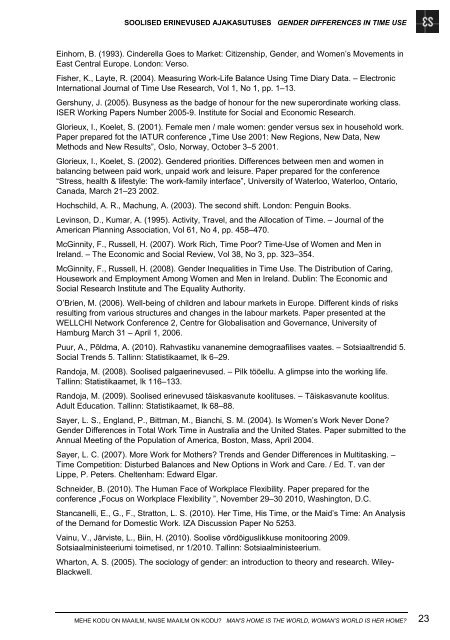MEHE KODU ON MAAILM, NAISE MAAILM ON KODU? - Tartu Ãlikool
MEHE KODU ON MAAILM, NAISE MAAILM ON KODU? - Tartu Ãlikool
MEHE KODU ON MAAILM, NAISE MAAILM ON KODU? - Tartu Ãlikool
Create successful ePaper yourself
Turn your PDF publications into a flip-book with our unique Google optimized e-Paper software.
SOOLISED ERINEVUSED AJAKASUTUSES GENDER DIFFERENCES IN TIME USE<br />
Einhorn, B. (1993). Cinderella Goes to Market: Citizenship, Gender, and Women’s Movements in<br />
East Central Europe. London: Verso.<br />
Fisher, K., Layte, R. (2004). Measuring Work-Life Balance Using Time Diary Data. – Electronic<br />
International Journal of Time Use Research, Vol 1, No 1, pp. 1–13.<br />
Gershuny, J. (2005). Busyness as the badge of honour for the new superordinate working class.<br />
ISER Working Papers Number 2005-9. Institute for Social and Economic Research.<br />
Glorieux, I., Koelet, S. (2001). Female men / male women: gender versus sex in household work.<br />
Paper prepared fot the IATUR conference „Time Use 2001: New Regions, New Data, New<br />
Methods and New Results”, Oslo, Norway, October 3–5 2001.<br />
Glorieux, I., Koelet, S. (2002). Gendered priorities. Differences between men and women in<br />
balancing between paid work, unpaid work and leisure. Paper prepared for the conference<br />
“Stress, health & lifestyle: The work-family interface”, University of Waterloo, Waterloo, Ontario,<br />
Canada, March 21–23 2002.<br />
Hochschild, A. R., Machung, A. (2003). The second shift. London: Penguin Books.<br />
Levinson, D., Kumar, A. (1995). Activity, Travel, and the Allocation of Time. – Journal of the<br />
American Planning Association, Vol 61, No 4, pp. 458–470.<br />
McGinnity, F., Russell, H. (2007). Work Rich, Time Poor? Time-Use of Women and Men in<br />
Ireland. – The Economic and Social Review, Vol 38, No 3, pp. 323–354.<br />
McGinnity, F., Russell, H. (2008). Gender Inequalities in Time Use. The Distribution of Caring,<br />
Housework and Employment Among Women and Men in Ireland. Dublin: The Economic and<br />
Social Research Institute and The Equality Authority.<br />
O’Brien, M. (2006). Well-being of children and labour markets in Europe. Different kinds of risks<br />
resulting from various structures and changes in the labour markets. Paper presented at the<br />
WELLCHI Network Conference 2, Centre for Globalisation and Governance, University of<br />
Hamburg March 31 – April 1, 2006.<br />
Puur, A., Põldma, A. (2010). Rahvastiku vananemine demograafilises vaates. – Sotsiaaltrendid 5.<br />
Social Trends 5. Tallinn: Statistikaamet, lk 6–29.<br />
Randoja, M. (2008). Soolised palgaerinevused. – Pilk tööellu. A glimpse into the working life.<br />
Tallinn: Statistikaamet, lk 116–133.<br />
Randoja, M. (2009). Soolised erinevused täiskasvanute koolituses. – Täiskasvanute koolitus.<br />
Adult Education. Tallinn: Statistikaamet, lk 68–88.<br />
Sayer, L. S., England, P., Bittman, M., Bianchi, S. M. (2004). Is Women’s Work Never Done?<br />
Gender Differences in Total Work Time in Australia and the United States. Paper submitted to the<br />
Annual Meeting of the Population of America, Boston, Mass, April 2004.<br />
Sayer, L. C. (2007). More Work for Mothers? Trends and Gender Differences in Multitasking. –<br />
Time Competition: Disturbed Balances and New Options in Work and Care. / Ed. T. van der<br />
Lippe, P. Peters. Cheltenham: Edward Elgar.<br />
Schneider, B. (2010). The Human Face of Workplace Flexibility. Paper prepared for the<br />
conference „Focus on Workplace Flexibility ”, November 29–30 2010, Washington, D.C.<br />
Stancanelli, E., G., F., Stratton, L. S. (2010). Her Time, His Time, or the Maid’s Time: An Analysis<br />
of the Demand for Domestic Work. IZA Discussion Paper No 5253.<br />
Vainu, V., Järviste, L., Biin, H. (2010). Soolise võrdõiguslikkuse monitooring 2009.<br />
Sotsiaalministeeriumi toimetised, nr 1/2010. Tallinn: Sotsiaalministeerium.<br />
Wharton, A. S. (2005). The sociology of gender: an introduction to theory and research. Wiley-<br />
Blackwell.<br />
<strong>MEHE</strong> <strong>KODU</strong> <strong>ON</strong> <strong>MAAILM</strong>, <strong>NAISE</strong> <strong>MAAILM</strong> <strong>ON</strong> <strong>KODU</strong>? MAN’S HOME IS THE WORLD, WOMAN’S WORLD IS HER HOME? 23

















